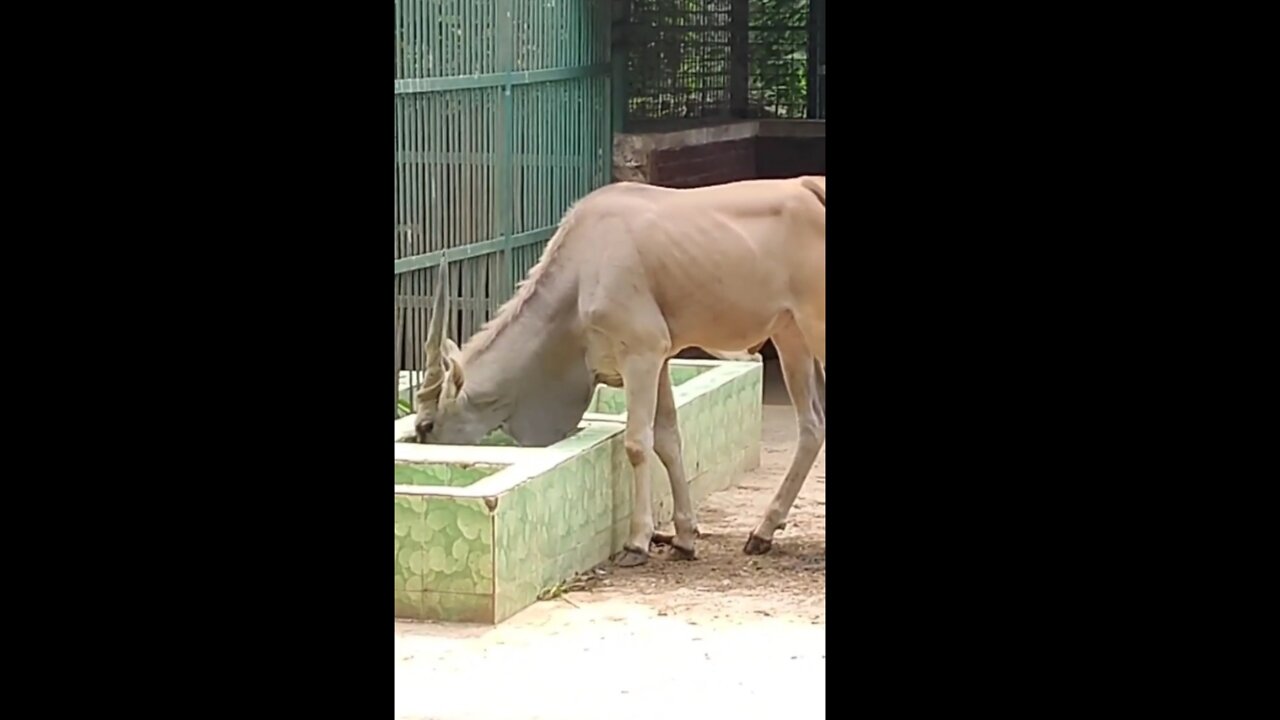Premium Only Content

Donkey and eland eting time.
The domestic donkey is a hoofed mammal in the family Equidae, the same family as the horse. It derives from the African wild ass, Equus africanus, and may be classified either as a subspecies thereof, Equus africanus asinus, or as a separate species, Equus asinus.[1]: 1 It was domesticated in Africa, probably about 5,000[1]: 2 or 6,000[2]: 3715 years ago, and has been used mainly as a working animal since that time.
Donkey
Conservation status
Domesticated
Scientific classificationKingdom:AnimaliaPhylum:ChordataClass:MammaliaOrder:PerissodactylaFamily:EquidaeGenus:EquusSpecies:
E. africanus
Subspecies:
E. a. asinus
Trinomial nameEquus africanus asinus
Linnaeus, 1758
Donkeys, feral, horse world distribution
There are more than 40 million donkeys in the world, mostly in underdeveloped countries, where they are used principally as draught or pack animals. While working donkeys are often associated with those living at or below subsistence, small numbers of donkeys or asses are kept for breeding or as pets in developed countries.
A male donkey is known as a jack or jackass, a female is a jenny or jennet,[3][4][5] and an immature donkey of either sex is a foal.[5] Jacks are often mated with mares to produce mules; the biological reciprocal of a mule, from a stallion and jenny, is a hinny.
The giant eland (Taurotragus derbianus), also known as the Lord Derby eland, is an open-forest and savanna antelope. A species of the family Bovidae and genus Taurotragus, it was described in 1847 by John Edward Gray. The giant eland is the largest species of antelope, with a body length ranging from 220–290 cm (86.5–114 in). There are two subspecies: T. d. derbianus and T. d. gigas.
Giant elandT. d. derbianus
SenegalT. d. gigas at the Cincinnati Zoo
Conservation status

Vulnerable (IUCN 3.1)[1]
Scientific classificationKingdom:AnimaliaPhylum:ChordataClass:MammaliaOrder:ArtiodactylaFamily:BovidaeSubfamily:BovinaeGenus:TaurotragusSpecies:
T. derbianus
Binomial nameTaurotragus derbianus
(J.E. Gray, 1847)
Subspecies
T. d. derbianus
T. d. gigas
Distribution of giant eland subspecies : Western giant eland
Eastern giant elandSynonyms
Species synonymy[2]
Tragelaphus derbianus (J.E. Gray, 1847)
Boselaphus derbianus J.E. Gray, 1847
Tragelaphus colini (de Rochebrune, 1883)
Tragelaphus typicus Rowland Ward, 1910
Tragelaphus gigas (Heuglin, 1863)
Tragelaphus cameroonensis Millais, 1924
Tragelaphus congolanus W. Rothschild, 1913
Tragelaphus derbii (Johnston, 1884)
The giant eland is a herbivore, eating grasses, foliage and branches. They usually form small herds consisting of 15–25 members, both males and females. Giant elands are not territorial, and have large home ranges. They are naturally alert and wary, which makes them difficult to approach and observe. They can run at up to 70 km/h (43 mph) and use this speed as a defence against predators. Mating occurs throughout the year but peaks in the wet season. They mostly inhabit broad-leafed savannas, woodlands and glades.
The giant eland is native to Cameroon, Central African Republic, Chad, Democratic Republic of the Congo, Guinea, Mali, Senegal, and South Sudan. It is no longer present in The Gambia, Ghana, Ivory Coast, and Togo. It can also be found in the Jos wildlife park in Nigeria, Guinea-Bissau, and Uganda due to over hunting and a lack of professional wildlife management. The subspecies have been listed with different conservation statuses by the International Union for Conservation of Nature (IUCN)
-
 1:03:42
1:03:42
Michael Franzese
1 hour agoShe Spent 36 Years in Prison for a Crime She Didn’t Commit
8.11K4 -
 LIVE
LIVE
Committee on House Administration
1 hour agoSubcommittee on Elections Hearing: “Revisiting the 2024 Election with Secretaries of State”
923 watching -
 1:01:58
1:01:58
The Football Terrace
3 hours ago $0.37 earnedGoldbridge SLAMS Neville's AGENDA! Carragher’s Arsenal AGENDA EXPOSED! Arsenal Ready for Madrid WAR
6.23K -
 1:24:27
1:24:27
Russell Brand
4 hours agoTrump THREATENS China As Xi Vows to ‘FIGHT TO THE END’ Against US Tariffs – SF562
134K28 -
 1:14:14
1:14:14
Sean Unpaved
3 hours agoGators' Road To Glory! Masters Tournament Preview with PGA Tournament Winner Mark Lye
21.1K2 -
 1:03:13
1:03:13
Timcast
4 hours agoLeftist ASSASSINATION Culture TAKING OVER, 55% Of Left Call For END Of Trump And Elon
197K146 -
 49:18
49:18
Ben Shapiro
4 hours agoEp. 2175 - REBOUND or FALSE SPRING? Has The Market Hit Bottom?
57.2K25 -
 2:24:38
2:24:38
The Confessionals
3 hours agoThe Rise of Nephilim Sex Magick
17.1K9 -
 58:27
58:27
The Tom Renz Show
3 hours agoThe SCOTUS on Aliens, The Flu Shot Gives You the Flu, & Trump's Tariffs
30.1K8 -
 2:40:51
2:40:51
IrishBreakdown
3 hours agoNotre Dame Offense Is Still A Work In Progress
32.8K